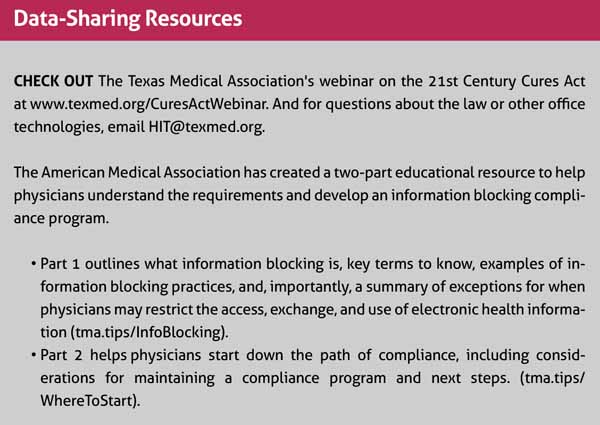
Starting April 5, physicians must be ready to electronically share with patients more of the information generated during office visits.
This change comes thanks to “information blocking” rules that are part of the 21st Century Cures Act, passed by Congress in 2016 and put into regulation in 2020 by the U.S. Department of Health and Human Services’ Office of the National Coordinator (ONC).
The Cures Act regulations eventually will enable widespread access and sharing of electronic health information (EHI) among physicians and their patients, for example, through smartphones or other devices.
Physicians, hospitals, electronic health record (EHR) vendors, health information exchanges (HIE), and health information networks (HIN) must comply with the regulations, says Joseph Schneider, MD, a pediatrician and chair of the Texas Medical Association’s Committee on Health Information Technology.
“Starting April 5, patients who request access to certain physician notes and reports in the EHR must be given electronic access to them, with a few exceptions,” he said.
Legally, patients already can obtain their entire medical record in printed form. The Cures Act gradually extends electronic access to those same records over the next two years. (See “21st Century Cures Act: What’s Next?” page 29.)

ONC extended the original November compliance deadline to April because physician offices have been preoccupied with COVID-19 (www.texmed.org/DataSharingDelay). While another extension could take place if the pandemic remains severe, physicians should not expect one, Dr. Schneider says.
Any physician offices that have not begun planning for the April 5 deadline need to start as soon as possible, he says.
“You won’t be able to do this overnight,” Dr. Schneider said.
But once physicians do, it likely will be worthwhile, says Manish Naik, MD, chief medical information officer at Austin Regional Clinic and a member of TMA’s Committee on Health Information Technology.
“Transparency will help strengthen that doctor-patient relationship – if it’s done correctly,” he said. “And I think there’s some preparation that needs to take place to recognize the full potential.”
Getting ready
The provisions that take effect in April require physicians to give their patients immediate electronic access to significant portions of their EHI upon request. This includes eight types of clinical notes; discharge summar-ies; history and physicals; progress notes; consult notes; imaging reports; laboratory reports; pathology reports; and procedure notes.
ONC does not specifically state that “open notes” are required (“open notes” refers to the automatic release of all clinical notes), Dr. Naik says.
“Our interpretation of the guidelines in April is that [doctors] don’t have to automatically release clinical notes,” he said. “But physicians and physician groups should be preparing for that to come.”
Physicians will have two immediate avenues for providing the patient information electronically: patient portals in EHRs or third-party companies that can send a secure email, Dr. Schneider says.
All physicians can expect to spend time and resources on compliance, but that will vary based on factors such as physician specialty and EHR vendor preparedness, he says. Some specialties will not have to focus heavily on privacy issues.
“But if you’re a pediatrician, [for instance], and take care of adolescents, you have some big challenges in terms of how you’re going to preserve the privacy that they’re entitled to and still comply with the laws,” he said.
Notable exceptions
Physicians first must understand what is considered “information blocking” under the Cures Act, Dr. Schneider says. They also must understand the law’s detailed exceptions (tma.tips/CuresActExceptions).
TMA and the American Medical Association have extensive resources to help. (See “Data-Sharing Resources,” page 31.)

For example, a physician who withholds a medical record to protect a patient from harm would not be considered to be information-blocking, Dr. Schneider says. This often comes up in cases of child abuse. If one parent suspects another parent of abuse and that is recorded in the physician’s notes, the physician must keep in mind that both parents have access to the records, he says. This could open up the child or reporting partner to further harm.
“Technologically, you have to prepare to make your notes available,” he said. “But depending upon your type of practice, you have to think about what you put in those notes and what notes that you wouldn’t share because they fit one of the exceptions.”
Many practices rely on third-party services to deliver HIPAA-protected information to patients in print, and that third party also could handle electronic requests, Dr. Naik says.
But for now, patient portals in EHRs are a better long-term solution, he says. In fact, physicians who rely on their patient portal heavily may be well-prepared for the April 5 deadline. Those practices already likely release information on medications, lab results, and imaging results over the portal, and adding patient notes should not be difficult.
“Enabling the ability to do that through the patient portal is the most direct way to go about meeting this requirement,” Dr. Naik said.
Physicians should speak to their EHR vendors about their capabilities and what the new law might cost their practice, Dr. Schneider says.
“The answer depends on the EHR company and the relationship you have with them,” he said. “In some places it will cost. In others it will be part of an upgrade that’s already covered.”
Physicians also should train staff to understand the new requirements and their role in enforcing any changes, Dr. Schneider adds. Again, the time and resources involved will depend on the practice.
He acknowledges physicians may fear that patients will “be calling up their physicians saying, ‘I disagree with this in my notes and you need to change this or that,’” but said, “so far in terms of the open note experience, that doesn’t seem to be a major problem.”
Open and effective
The law is designed to promote greater openness with patients, and many physicians who have tried it say it works, Dr. Naik says, pointing to recent studies.
A March 2020 web survey of 1,628 physicians and other clinicians with a history of sharing notes with patients found that 74% agreed that it was good idea, and 74% viewed it as useful for engaging patients in their care, according to JAMA Network Open (tma.tips/OpenNotesSurvey).
Austin Regional Clinic is transitioning to meet the law’s requirements, but its patient portal has gradually opened access to patient records, Dr. Naik says.
“We went live with a patient portal in 2013 and gradually built upon it,” he said. “We started with just showing the lists of diagnoses, medications, allergies, and immunizations. Then we added labs, and then we added imaging. It has helped our patients understand much better what’s going on with their own health and has been a huge benefit in terms of communicating with patients.”
But the JAMA report warns of at least one major drawback.
“Approximately one-third of clinicians report that because of open notes they are spending at least some additional time in documentation,” the survey found.
That additional time often takes the form of making notes easier for patients to understand, Dr. Naik says. For instance, a physician might adjust a typical note that reads “abnormal scan – rule out cancer” to something more patient-friendly, like: “There’s an abnormality on the chest X-ray. Elaborate on differential diagnoses. I’m not as concerned about cancer because the patient’s not a smoker, but we need to rule that out.”
While this might take more time at first, physicians will learn to better address potential patient concerns in their notes, Dr. Naik says.
“You don’t have to take out the clinical terminology, but I think you do have to expound a little bit more on what the game plan is for the patient,” he said.
Any drawbacks to open notes need to be weighed against the benefits, the JAMA report says. Previous studies show that patients who are able to access their medical records electronically feel more in control of their care and have a better grip on what their clinician is thinking, study authors reported.
Also, patients can go back and review information, giving them a better chance to absorb what’s there and make sense of it, Dr. Naik says.
Tex Med. 2020;117(1):28-31
January 2021 Texas Medicine Contents
Texas Medicine Main Page